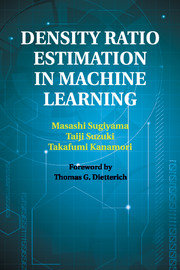Book contents
- Frontmatter
- Contents
- Foreword
- Preface
- Part I Density-Ratio Approach to Machine Learning
- Part II Methods of Density-Ratio Estimation
- Part III Applications of Density Ratios in Machine Learning
- Part IV Theoretical Analysis of Density-Ratio Estimation
- Part V Conclusions
- List of Symbols and Abbreviations
- Bibliography
- Index
Part III - Applications of Density Ratios in Machine Learning
Published online by Cambridge University Press: 05 March 2012
- Frontmatter
- Contents
- Foreword
- Preface
- Part I Density-Ratio Approach to Machine Learning
- Part II Methods of Density-Ratio Estimation
- Part III Applications of Density Ratios in Machine Learning
- Part IV Theoretical Analysis of Density-Ratio Estimation
- Part V Conclusions
- List of Symbols and Abbreviations
- Bibliography
- Index
Summary
In this part we show how density-ratio estimation methods can be used for solving various machine learning problems.
In the context of importance sampling (Fishman, 1996), where the expectation over one distribution is computed by the importance-weighted expectation over another distribution, density ratios play an essential role. In Chapter 9, the importance sampling technique is applied to non-stationarity/domain adaptation in the semi-supervised learning setup (Shimodaira, 2000; Zadrozny, 2004; Sugiyama and Müller, 2005; Storkey and Sugiyama, 2007; Sugiyama et al., 2007; Quiñonero- Candela et al., 2009; Sugiyama and Kawanabe, 2011). It is also shown that the same importance-weighting idea can be used for solving multi-task learning (Bickel et al., 2008).
Another major usage of density ratios is distribution comparisons. In Chapter 10, two methods of distribution comparison based on density-ratio estimation are described: inlier-base outlier detection, where distributions are compared in a pointwise manner (Smola et al., 2009; Hido et al., 2011), and two-sample tests, where the overall difference between distributions is compared within the framework of hypothesis testing (Sugiyama et al., 2011c).
In Chapter 11 we show that density-ratio methods allow one to accurately estimate mutual information (Suzuki et al., 2008, 2009a). Mutual information is a key quantity in information theory (Cover and Thomas, 2006), and it can be used for detecting statistical independence between random variables.
- Type
- Chapter
- Information
- Density Ratio Estimation in Machine Learning , pp. 117 - 118Publisher: Cambridge University PressPrint publication year: 2012



